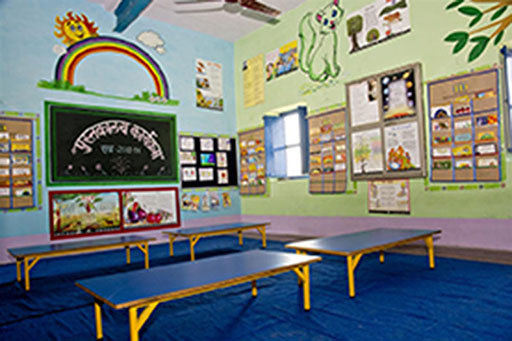2 Examples of writing in the classroom
The classroom can contain many examples of writing for your students to read. Such writing may be on the blackboard, on signs and notices, on charts, posters and labels, and in displays of your students’ work.
Case Study 1: Learning from writing in the classroom
Ms Shruti, a Class I teacher from Indore, shares her approach to creating a writing-rich classroom for her students.
I know that my young students need many opportunities to listen and speak in the classroom. Even though most can’t read and write yet, I recognise the importance of exposing them to different examples of text as well, whether handwritten or in print.
I have a small collection of colourful posters, such as alphabet (Varnamala) and word charts. These I position on the wall at the eye-level of the children.
I make name labels for each child, which I ask them to illustrate. I attach these next to the wall hooks where they store their coats and bags. I also have a set of folded-over cardboard name cards, which I place where I wish students to sit for particular activities, either in pairs or small groups. These labels are useful in helping my students to recognise their names in writing, as well as those of their classmates.
Using coloured paper, I also make labels for the different features of the classroom. These include words like ‘door’, ‘window’, ‘blackboard’, ‘cupboard’, ‘table’, ‘chair’, ‘desk’ and ‘clock’.
I ask my students to help me put the right label on each item. First I read the word aloud, focusing on the letters and matras. Then my students indicate where the label should go. Sometimes my students suggest another classroom item to label. In these instances, I say the names of the letters as I write out their suggestion.
In one part of the classroom, I have created a word wall. This is where I post up the new words that my students have encountered during the week. I also encourage my students to write these words up themselves.

Pause for thought
|
Activity 2: Creating a writing-rich classroom
Set aside 15 minutes to notice ways in which writing currently features in your classroom:
- What form does this take?
- Is it stimulating for your students? How does it contribute to their learning?
- How often it is changed?
- If it includes your students’ work, how inclusive is the selection displayed?
Talk to two of your colleagues. What examples of writing feature on their classroom walls?
How can you increase and vary the range of student work you display in your classroom? How can you use your own writing imaginatively to provide interesting, age-appropriate reading materials for your students? Make a plan of your classroom wall space and consider how you could use it more effectively. Set yourself a commitment to add to or change some of the displays in your classroom every fortnight if possible. Encourage your colleagues to do the same. Visit one another’s classes every so often to view and learn from each other’s wall displays.
1 Examples of writing in the local environment
